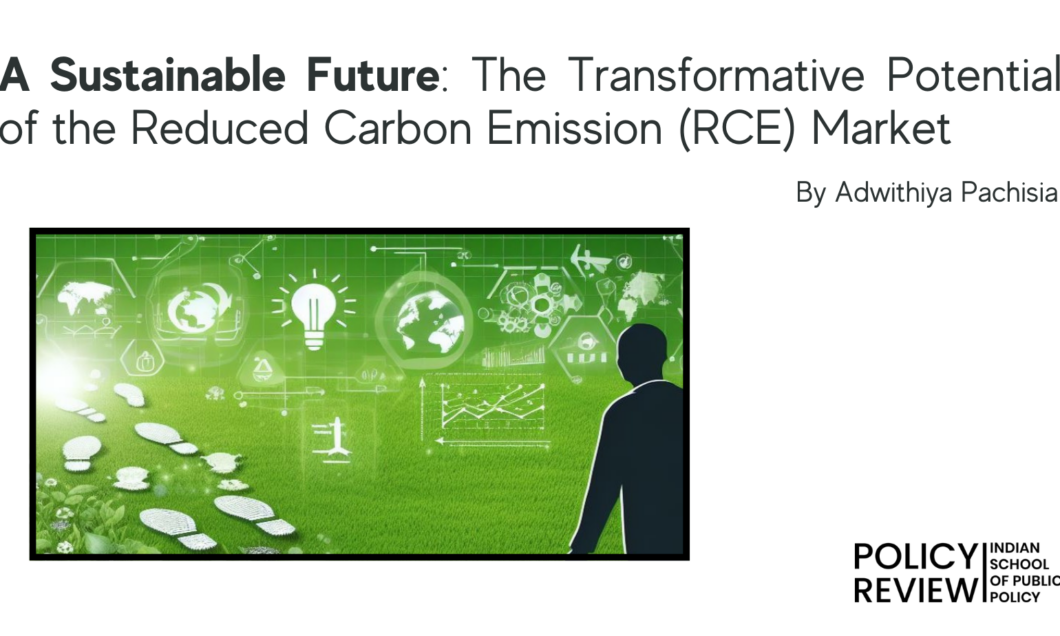
A Sustainable Future: The Transformative Potential of the Reduced Carbon Emission (RCE) Market

As countries convene at COP-28 to collectively address climate challenges, this essay unveils the transformative promise of the Reduced Carbon Emission (RCE) market. In the face of climate change challenges, we must explore solutions addressing environmental issues while providing economic incentives for businesses. The “Reduced Carbon Emission” (RCE) market emerges as a promising approach, establishing a symbiotic relationship between environmental stewardship and economic prosperity. To illustrate the essence of this innovative market, consider a hypothetical family scenario: a son earning a stipend for working with his father and a sister with free time after school. Their mother incentivises them to clean their room by promising a delightful reward—a chocolate bar. A twist unfolds when the brother, recognising the value of his sister’s time, proposes to share a portion of his stipend in exchange for her assistance in the cleaning task, securing them the coveted chocolate. This seemingly simple exchange mirrors the essence of the RCE market on a larger scale—a dynamic where larger entities support smaller ones in pursuing shared goals.
Refining the definition, the RCE market involves a government-issued certificate system that commends smaller companies actively engaged in innovative practices to mitigate climate risks and reduce carbon footprints. These certificates become tangible symbols of the significant environmental impact achieved by these smaller entities. In the envisioned RCE market, the government issues special certificates to commendable smaller companies and startups actively engaged in innovative practices to mitigate climate risks and reduce carbon footprints. These certificates become tangible symbols of the significant environmental impact achieved by these smaller entities. To ensure the effectiveness of the regulatory framework, larger companies are mandated to purchase these certificates from their smaller counterparts after a specified period. Failure to comply incurs substantial fines, creating a strategic regulation that encourages larger corporations to invest in and support smaller enterprises focused on climate mitigation.
Operating as a dynamic auction, the Reduced Carbon Emission (RCE) certificate market involves larger companies competitively bidding to acquire limited government-issued certificates. This system creates a robust and competitive environment, intensifying the certificate demand and driving prices. The competitive bidding process is crucial due to the scarcity of these certificates, regulated by the government. In this setup, larger companies compete fiercely to secure certificates, ensuring fair compensation for smaller enterprises. As larger corporations aim to avoid fines, they offer the best prices in the auction, aligning economic motives with environmental goals. This strategic auction system establishes a competitive marketplace for a limited environmental asset, guaranteeing that smaller companies actively contributing to climate mitigation receive fair and competitive compensation for their efforts. The fluctuating prices within this market dynamic reflect larger corporations actively investing in and supporting smaller businesses. This support fosters innovation and contributes to sustainability in carbon reduction technologies. In essence, the dynamic auction system ensures that smaller and larger companies have a stake in environmental responsibility, creating a balanced and mutually beneficial ecosystem.
Crucially, the government’s role extends beyond mere environmental motives; it’s aimed at driving social change by stimulating innovation in smaller companies. To achieve this, the government provides various incentives, including grants, subsidies, or low-interest loans, to encourage startups and smaller enterprises to participate actively in the RCE market. These incentives serve as financial support mechanisms, boosting research and development efforts within these companies. By offering such support, the government ensures that these businesses comply with regulatory standards, thrive, and contribute meaningfully to environmental initiatives.
One might question why larger companies would only independently invest in climate mitigation techniques without a regulatory system. While it’s true that larger companies could have invested in such measures in the past, the crucial distinction lies in the absence of government incentives and certification. The proposed Reduced Carbon Emission (RCE) market, backed by government regulation, introduces a structured system that encourages and compels larger corporations to participate actively. Without such a system, larger companies might lack the necessary incentives to invest in mitigation efforts proactively. Unlike smaller enterprises, they wouldn’t receive government-issued certificates for their environmental contributions. These certificates, tangible proof of their commitment to reducing carbon emissions, play a vital role in the proposed market dynamics. The certifications validate their efforts and become tradable assets in the dynamic auction system, ensuring fair compensation for their contributions.
The benefits of the RCE market are vast. It actively encourages companies to reduce carbon emissions and stimulates the economy through job creation and investment in cleantech research. Larger companies fulfil their obligations while supporting smaller counterparts, creating a transformative model that demonstrates environmental responsibility can be both profitable and inclusive. In traditional carbon markets, the focus has often been on penalizing and charging for emitting carbon, inadvertently commodifying it and emphasising the problem rather than the solution. However, the proposed paradigm shift emphasises “Reduced Carbon” instead of focusing on carbon emissions. This change in terminology carries a more positive connotation within the realm of economics and climate change, promoting the adoption of sustainable and environmentally friendly practices driven by economic motives, moral behaviour, and environmental stewardship.
The government, recognising the hesitations of businesses due to high investment costs and uncertain returns, plays a pivotal role as a catalyst for change. By incentivizing businesses to develop strategies for reducing their carbon footprint, the government initiates a process that leads to tangible reductions in carbon emissions. When accumulated, Companies are rewarded with certificates, which become mandatory for larger corporations with larger carbon footprints to purchase. This approach creates a symbiotic relationship between large and small companies, promoting the flow of capital from major corporations into smaller businesses and fostering innovation in carbon reduction technologies. The vision is akin to the brother recognising the value of his sister’s time in the earlier example, where larger entities actively invest in and back to smaller ones, ultimately contributing to a sustainable and prosperous future.
In conclusion, the Reduced Carbon Emission (RCE) market represents a paradigm shift in our climate change strategy, incentivizing emission reduction for businesses, promoting environmental responsibility, and stimulating economic growth. This transformative concept harmonizes innovation, sustainability, and profitability, offering a promising path forward for our planet. Embracing the RCE market means embracing a future where economic success and environmental health go hand in hand, envisioning a world where it becomes a cornerstone of global efforts to combat climate change, and fostering a sustainable and prosperous future for generations to come.
References
1) Guinot, J., Barghouti, Z., & Chiva, R. (2022). Understanding Green Innovation: a Conceptual Framework. Sustainability, 14(10), 5787. https://doi.org/10.3390/su14105787
2) Gray, R. H. (1994). Corporate Reporting for Sustainable Development: Accounting for Sustainability in 2000AD. Environmental Values, 3(1), 17–45. https://doi.org/10.3197/096327194776679782
3) Nisiforou, O., Shakou, L. M., Magou, A., & Charalambides, A. G. (2022). A Roadmap towards the Decarbonization of Shipping: A Participatory Approach in Cyprus. Sustainability, 14(4), 2185. https://doi.org/10.3390/su14042185
4) Kahn, J. R. (1995). The economic approach to environmental and natural resources. https://ci.nii.ac.jp/ncid/BA32729110
5) Franki, N. (2022). Regulation of the voluntary carbon offset market. Columbia Journal of Environmental Law, 48(1), 39. https://doi.org/10.52214/cjel.v48i1.10442
6) Agorman. (2023, June 2). Corporations have a role to play in Africa’s development through carbon markets. They should take it seriously. Atlantic Council. https://www.atlanticcouncil.org/blogs/africasource/through-carbon-markets-corporations-have-a-role-to-play-in-africas-development-they-should-take-it-seriously/
7) The Editorial Board. (2023, October 31). Climate change: Global green investment splurge needs new guardrails. Bloomberg.com. https://www.bloomberg.com/opinion/articles/2023-10-31/climate-change-global-green-investment-splurge-needs-new-guardrails
8) Tuerk, M. (2022, November 23). Clean Tech Year in Review – Key takeaways from a Challenging year in the market. Forbes. https://www.forbes.com/sites/miriamtuerk/2022/11/23/clean-tech-year-in-review–key-takeaways-from-a-challenging-year-in-the-market/?sh=75e0b22b1dc9

Adwithiya Pachisia
PDM Scholar, Class of 2024,
Adwithiya Pachisia is a well-informed individual adept in research domains and study methodologies. Displaying exceptional organizational skills and a strong sense of responsibility, he possesses extensive knowledge of economic theories and public economics. Adwithiya’s impactful contributions extend to operational enhancement through his exceptional communication prowess and sharp critical thinking abilities.

